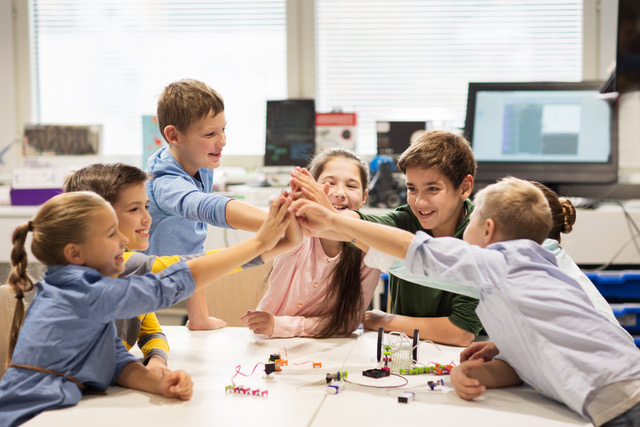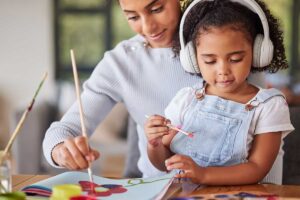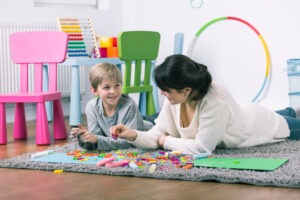“Children are the world’s most valuable resource and its best hope for the future.” – John F. Kennedy.
When Do Perspective-Taking Abilities Develop?
As early as during the infant and toddler years, children usually start to learn concepts that help them develop theory of mind skills (the ability to take someone else’s perspective).
If I make a funny sound, my family will clap.
If I throw my cup, my mom will be angry.
I can dress up like a vet and pretend to help animals.
Between the ages of 4 to 6, children truly develop the ability to take another person’s perspective, according to Michelle Garcia Winner, MA, CCC-SLP, founder and CEO of Social Thinking. One very important skill they’ll start to learn? People can have different, but possibly both true, beliefs about the same thing. They act based on what they think is going to happen. Around this age, children also start to understand the concept of “false beliefs” – that people can believe things that aren’t true, and that they might act according to that.
Perspective-taking abilities continue to develop throughout childhood – and some would argue – through adulthood.
Why Understanding Others Can be Difficult
Some children may struggle to develop social skills like perspective-taking in the typical order or timeline. This includes children on the Autism Spectrum and those with social skill impairments or language delays. They may have trouble shifting between their own perspective and that of someone else. Or, they may not have developed empathy yet (the ability to understand the emotions of others). Luckily, there are some research-based techniques we as parents can use to help our children learn to develop this important life skill!
Tip #1: Talk about Thoughts & Feelings
Studies show that when mothers use words related to thoughts and feelings, it helps their child develop theory-of-mind understanding. Siblings can have a similar influence too, so setting up a home environment that encourages use of language about emotions can be helpful. Using self-talk is one way to incorporate these concepts. For example, “I was worried when I couldn’t find my keys! I’m so relieved now that I found them and we can drive to the park,” is a good way to describe thoughts and feelings to your kids.
Ask children and their siblings about their day at school using specific questions. Instead of “how was your day?”, ask something along the lines of, “what was something that made you feel proud (or happy, sad, angry, etc.) today?
Tune into your child’s feelings. Restate what your child says and help him or her identify the emotion they seem to be showing. Not only will you help your child develop understanding of different feelings, but you’re also walking the walk by showing them you respect and acknowledge their feelings. You’re modeling how to recognize the attitudes of others!
Tip #2: Learn through Literacy
Reading is a wonderful way to teach your child how to take someone’s perspective. As you and your child read together, talk about the characters in the book. Point out nonverbal cues like the characters’ facial expressions and body language and ask your child what he or she thinks the characters are thinking or feeling.
Ask questions during story time about why characters are acting certain ways. Try pausing before turning pages and to work on your child’s inferencing skills. Asking him or her to predict what the characters might do next and why. Studies show it’s important to relate the events of a story to your child’s own experiences to help them truly understand thoughts, feelings, and choices. If you’re reading about a boy who was sad because nobody passed him the ball at basketball practice, ask your child about a time he or she felt left out and how they reacted.
Tip #3: Role Play
Role playing can help children of all ages learn how to stay receptive to different sides of a discussion with others. Model and teach conversational skills like turn taking and “whole body listening” while acting out scenarios with your child (think: pretend play or dress-up for younger children and acting scenes from movies or school with older kids). “Whole body listening” means using behaviors like looking at the speaker, keeping your hands and feet still, and focusing your thoughts on what the other person is saying. Be clear while giving examples of certain phrases your child can use during discussions to have an appropriate conversation. These can be things like, “I agree because…”, “I don’t understand…”, or “Can you explain…?”.
Encourage your child to put these behaviors into action during moments like dinner time discussions with the family. Have a family game night playing a conversation-sparking game like TableTopics, and guide your child to put the perspective taking skills you’ve worked on into play!
If you are concerned with your child’s social skills or speech and language development, a Speech-Language Pathologist (also known as a “Speech Therapist”) can conduct an evaluation to assess these areas. The therapist will provide recommendations, which might include your child attending regular speech therapy to improve their skills. TherapyWorks provides Speech, Occupational, Feeding and Physical Therapy Services in-home and via teletherapy – a safe, convenient, and effective option.








